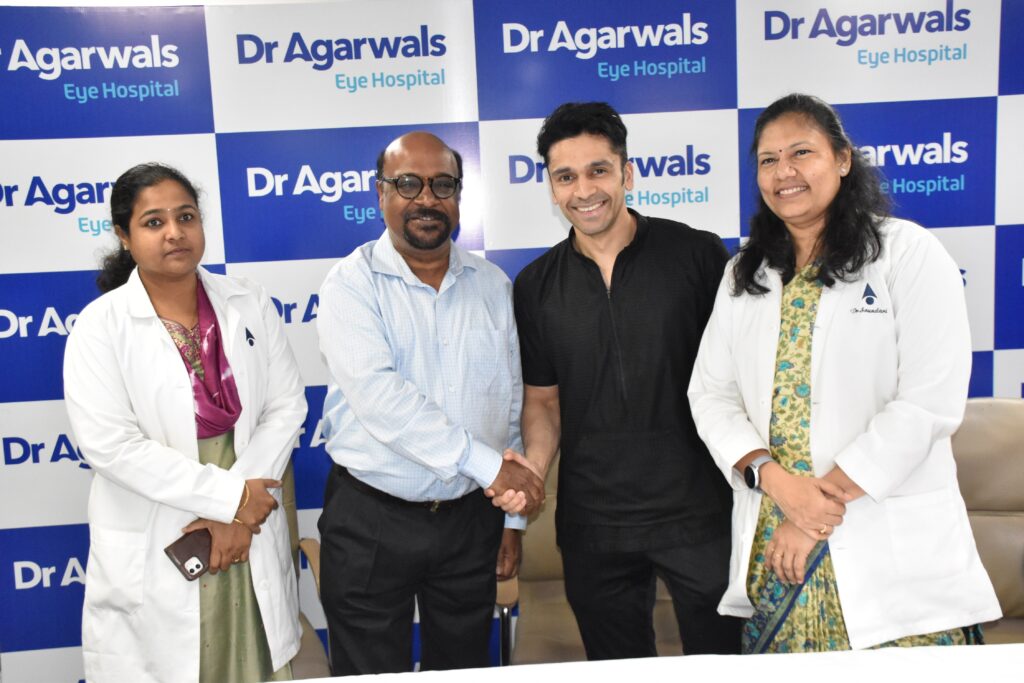Chennai, 19 January 2024: A minimally invasive glaucoma surgery (MIGS) performed at Dr Agarwals Eye Hospital, Chennai freed a 63-year old glaucoma patient from his 10-year long daily dependency on antiglaucoma eye drops. The 10-minute MIGS surgery performed by the hospital’s competent surgical team significantly reduced the eye (intraocular) pressure, the root cause of glaucoma, thusmaking it unnecessary for the patient to use eyedrops every day to curb the progression of the condition.
Glaucoma is the second most diagnosed eye disorder and the third leading cause of blindness. It affects 3 in 100 people. There are approximately 76 million people who have this condition worldwide. In India, about 11.9 million people aged 40 years and older live with it. Glaucoma is an irreversible and a progressive optic neuropathy. It occurs when the intraocular pressure increases as a result of either an increase in the inflow of fluids into the eye or a decrease in the outflow. The increased pressure damages optic nerves. MIGS can reduce the intraocular pressure by enhancing the outflow of fluids using several techniques, such as implanting micro stents to enhance the eye’s drainage system.
In the case of this senior citizen, a resident of Chennai, the surgical team at Dr Agarwals placed two stents inside the eyes which improved the fluid outflow. The surgery achieved about 35% reduction in intraocular pressure. This reduction is enough for the patient to stop using eye drops. He will have to be on the follow up for periodic pressure monitoring and nerve testing alone.
Talking about the benefits of MIGS, Dr. Ashvin Agarwal, Executive Director & Chief Clinical Officer of Dr Agarwals Eye Hospital said that MIGS is a new category of glaucoma surgery that has transformed the landscape of glaucoma management by providing a safer and less invasive alternative to trabeculectomy. It has been specifically developed with the goal of reducing the risk of complications associated with traditional glaucoma surgeries. With MIGS, there is a negligible disruption to normal anatomy through this microinvasive and sutureless approach. This gives the patient a faster healing time and rapid recovery. It provides a better 24 hour IOP control. There are many types of MIGS procedures and devices available in India, including Istent, Kahooks dual blade, BANG and GATT. “Thanks to MIGS, there has been a significant improvement in the quality of life of glaucoma patients. They can enjoy the freedom from eye drops – or a reduction in the number of medications. At Agarwals, we have an 80% success rate with close to 50% of the cases achieving over 40% intraocular pressure reduction.”
In her comments, Dr. S. Soundari, Regional Head – Clinical Services, Dr Agarwals Eye Hospital, said that glaucoma is a silent killer, as the progression of this condition isn’t noticed till the last stages. Usually, the patient comes into the hospital too late. No proper cure has been found for the disease till date. So the only treatment that we have is medical or surgical management. Although glaucoma is progressive, early intervention can usually prevent further vision loss or blindness. Glaucoma therapy includes different methods to lower the intraocular pressure, such as medications, laser, and surgery. In the case of mild glaucoma, eye drops are recommended. In moderate to severe cases, surgery is inevitable.”
She added that the conventional surgery, known as trabeculectomy, creates a new drainage pathway. With this method, there is always a risk of over-filtration, which could result in too little intraocular pressure, and infection at the surgical site. In MIGS surgeons use the normal drainage mechanics of the eye to enhance fluid outflow.
Considering the life changing benefits of MIGS, Dr Agarwals is Launching an Annual Glaucoma Patient Summit, a first-of-its-kind event in the city in March this year to facilitate direct interactions between the hospital’s experts and the patients to raise awareness about glaucoma and its understanding.


